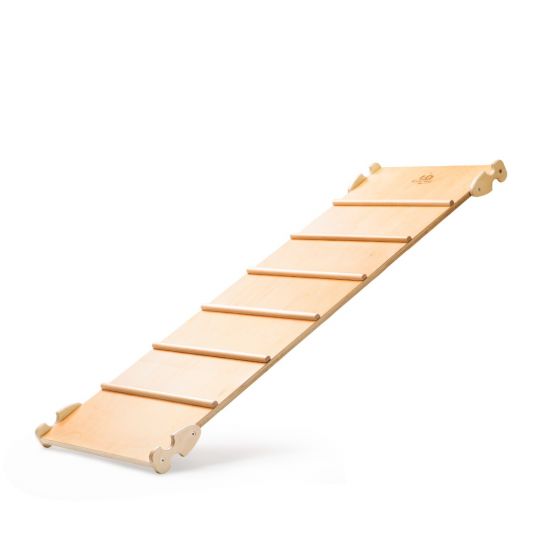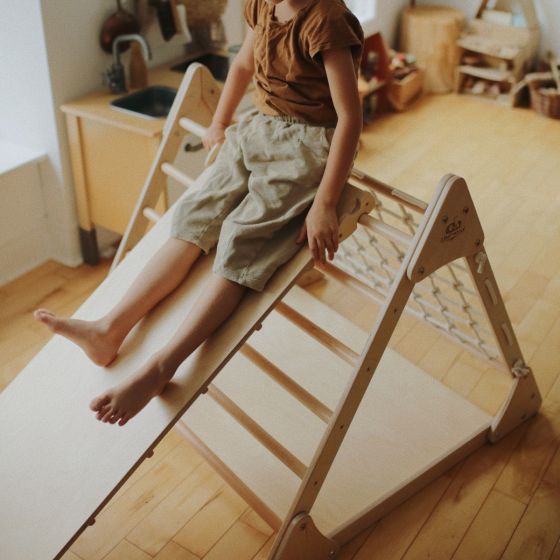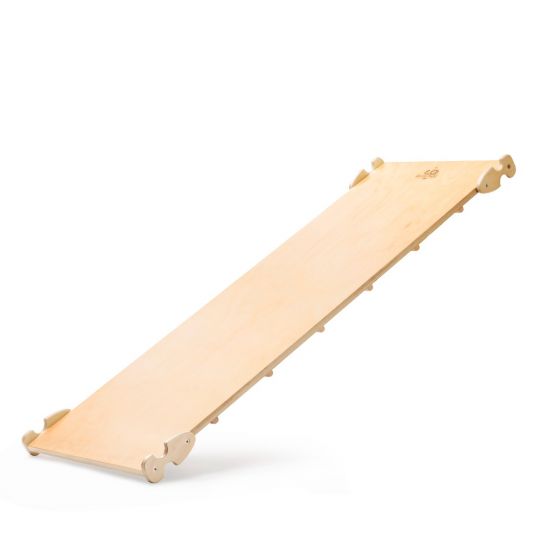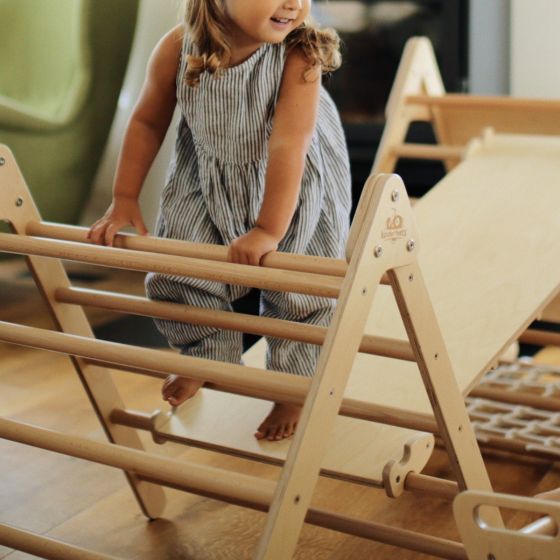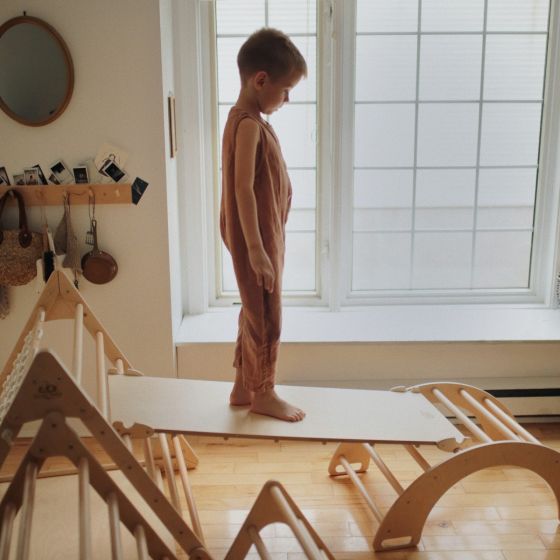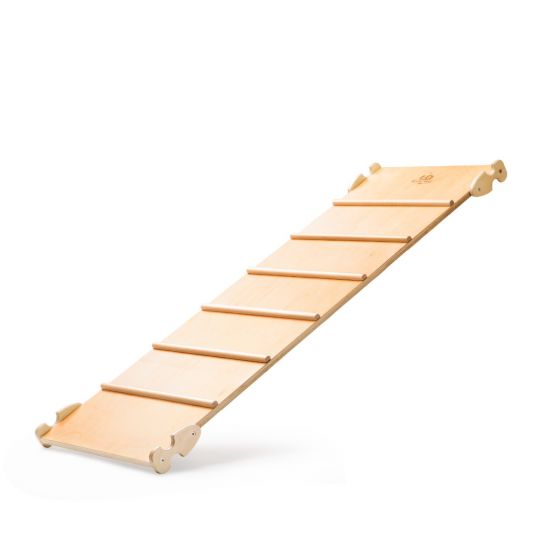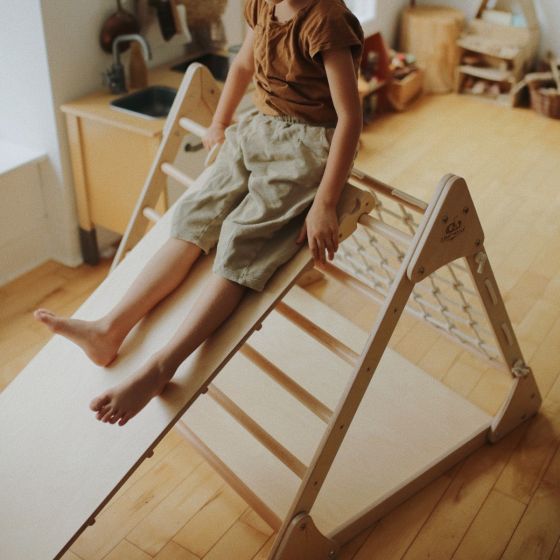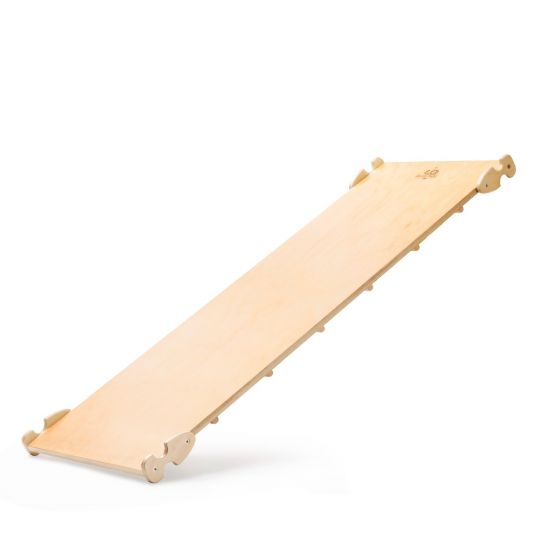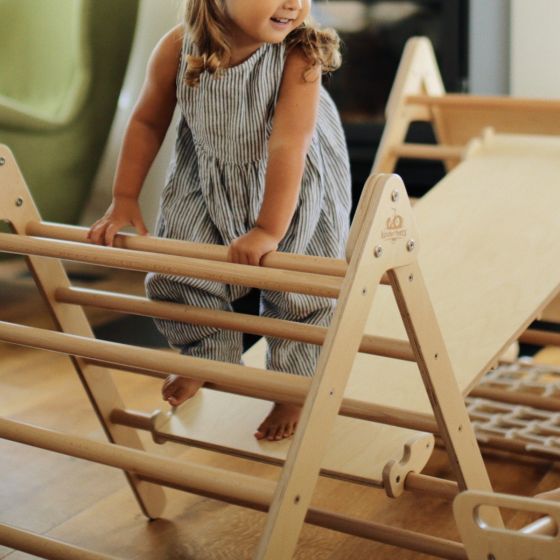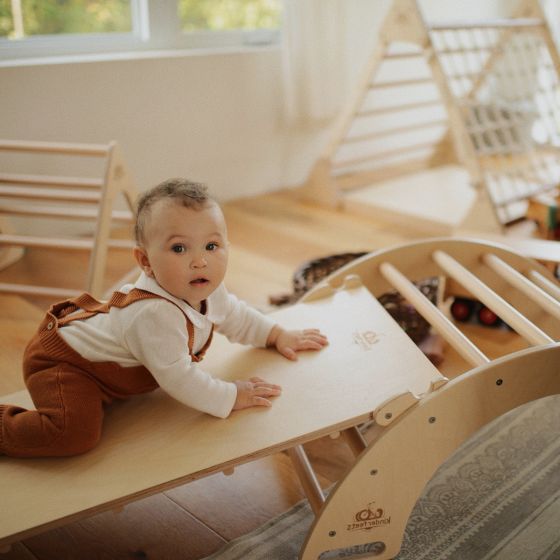Pikler Ramp & Slide
Pikler Ramp & Slide
SKU:KF065
Clothing Prem to 18 Months
| Size | Age Guide | Weight | Height |
|---|---|---|---|
| Premature | Premature or Small Newborn | Up to 4Kg | Up to 55cm |
| Newborn | 0-3 months | 4-6Kg | Up to 62cm |
| 3 Month | 3-6 months | 6-8Kg | Up to 68cm |
| 6 Month | 6-12 Month | 8-10Kg | Up to 76cm |
| 12 Month | 12-18 Month | 10-12Kg | Up to 84cm |
| 18 Month | 18-24 Month | 12-14Kg | Up to 92cm |
Clothing 2 to 6 Years
| Size | Age Guide | Height | Chest | Waist | Hip |
|---|---|---|---|---|---|
| 2 Year | 2-3 Years | Up to 100 cm | 56 | 51 | 58 |
| 3 Year | 3-4 Years | Up to 105 cm | 58 | 53 | 60 |
| 4 Year | 4-5 Years | Up to 110 cm | 60 | 55 | 62 |
| 5 Year | 5-6 Years | Up to 115 cm | 62 | 57 | 64 |
| 6 Year | 6-7 Years | Up to 120 cm | 64 | 59 | 66 |
Beanie Size Guide
| Size | Head Circumference | Age Guide |
|---|---|---|
| Premature | 31-35 cm | Premature or Small Newborn |
| Newborn | 35-40 cm | Newborn |
| Small | 40-43 cm | 3-6 Months |
| Medium | 43-47 cm | 6-18 Months |
| Large | 47-52 cm | 18-3 Years |
Sunhat Size Guide
| Size | Head Circumference | Age Guide |
|---|---|---|
| Newborn | 37-40 cm | Newborn |
| Small | 40-43 cm | 3-6 Months |
| Medium | 43-46 cm | 6-12 Months |
| Large | 46-49 cm | 12-24 Months |
| Xtra Large | 49-54 cm | 2-4 Years |
Sleep Pods Size Guide
| Size | Weight | Age Guide | Measurement(Back to Hem) |
|---|---|---|---|
| Newborn | 0-6 kgs | 0-3 Months | 60.5 cm |
| Small | 0-8 kgs | 3-6 Months | 66 cm |
Booties Size Guide
| Size | Age Guide |
|---|---|
| Newborn | 0-3 Months |
| Small | 3-6 Months |
| Medium | 6-12 Months |
| Large | 12-18 Months |
Pretty Brave Baby
| Foot Length (mm) | Insole Length (mm) | EU | UK | Age | INT |
|---|---|---|---|---|---|
| 95-104 | 110 | 16/17 | 2 | 0-6m | S |
| 104-114 | 118 | 18 | 3 | 6-12m | M |
| 114-123 | 127 | 19/20 | 4.5 | 12-18m | L |
| 123-137 | 142 | 21/22 | 5.5 | 16-22m | XL |
Pretty Brave 1st Walker
| Foot Length (mm) | Insole Length (mm) | EU | UK | Age |
|---|---|---|---|---|
| 114-120 | 125-128 | 19 | 3 | 1 yr |
| 120-126 | 132-135 | 20 | 3.5 | 1-2 yrs |
| 126-132 | 138.5-141.5 | 21 | 4.5 | 1-2 yrs |
| 132-138 | 145-148.5 | 22 | 5 | 2 yrs |
Crywolf Swim Nappy
| Size | Length (waist to crotch) | Crotch Width (side to side) |
|---|---|---|
| 0-1 yr | 1-2 yrs | |
| 37 | 38 | |
| 14.5 | 15.5 |
Crywolf Rash Suit
| Size | Length (back neck to crotch) | Chest (arm to arm) | Waist (side to side) | Sleeve (neck to cuff) | Neck Opening(diameter) |
|---|---|---|---|---|---|
| 6-12 Months | 1 yr | 2 yrs | 3 yrs | ||
| 40 | 42 | 44 | 46 | ||
| 25 | 26 | 27 | 28 | ||
| 24 | 25 | 26 | 27 | ||
| 30 | 31.5 | 33 | 34.5 | ||
| 13.25 | 13.25 | 13.8 | 14.3 |
In stock
Couldn't load pickup availability
Overview
Overview
The dual-sided Pikler Ramp & Slide offers endless possibilities, transforming seamlessly into various structures. Today, it's a slide; tomorrow, a climbing apparatus; and the next day, a bridge. Next week, it might become a walkway or even serve as the imaginative gateway to your castle!
Technical Specification
Technical Specification
User Guide
User Guide
Delivery and Returns
Delivery and Returns
- Delivery: Free within NZ on orders over $100 (excluding bulky items) or $8 standard shipping
- Returns: Accepted within 14 days of receipt with proof of purchase
- Some items are excluded from returns including sale items, hardware, car seats, prams, monitors and personal items - please click here for the full list.
Share this product
Recently Viewed Products
Related Blogs
Cradle Cap: Everything you need to know
Learn How to Combat Cradle Cap Becoming a new parent is a time filled with pure love and joy, but it can also come with moments of worry. It’s completely natural to stay up late, carefully listening to every sound or noticing every little skin change, wondering if it’s something to be concerned about. One common worry for new parents is cradle cap. The good news? It’s harmless and often clears up on its own, or with a bit of help. Let’s take a look at what cradle cap is, how to treat it, and when to reach out to your doctor if needed. What Is Cradle Cap? Cradle cap, also known as infantile seborrheic dermatitis, is a non-inflammatory skin condition that often appears in the first few months of life. It causes scaly patches on your baby’s scalp, which can be yellow or white. Though it may look uncomfortable, cradle cap isn’t painful, itchy, or a cause for concern. It’s not contagious and does not indicate poor hygiene. Why Does Cradle Cap Happen? Doctors aren’t entirely sure why babies develop cradle cap, and say it’s not preventable. Some suggest it might be related to hormones passed from mum to baby before birth, which can cause sebaceous glands to become overactive. This leads to the oily, thick scales that form on the scalp. Cradle cap typically clears up by the time your baby reaches 6 to 12 months. Top Tips for Treating Cradle Cap 1. Use a nourishing oil Before washing, apply a baby-safe oil to loosen flakes and nourish the scalp - we love Cradle Cap Fighter for this. Let it soak for at least an hour if you can. 2. Be gentleDon’t be tempted to pick or scratch - this will avoid any infection or irritation. 3. Loosen flakes gentlyUse a soft brush or fine-toothed comb to lift the softened flakes, taking gentle care. We love the Shnuggle Baby Brush for this bit. Brush gently in a slow circular motion without scrubbing. 4. Rinse wellApply a gentle baby shampoo to remove all oil residue, and then rinse the scalp very well to prevent product build-up or irritation. 5. Wash regularlyClean your baby’s scalp daily. You can repeat these steps as many times as you need to, but always be gentle. With consistent care, the flakes will gradually lift and clear. 6. Try a medicated shampoo (if needed)If the cradle cap doesn’t improve, check with your GP about using a medicated baby shampoo designed for sensitive skin. 7. Keep skin hydratedUsing a humidifier in your baby’s room can help prevent dryness and support overall skin health. 8. Know when to seek adviceCradle cap usually resolves on its own, but if it becomes inflamed, persists for several months, or spreads - consult your doctor for tailored treatment options. Cradle Cap Is Harmless and Temporary Cradle cap can be concerning for new parents, but rest assured, it’s a harmless and temporary condition. With gentle care and the right treatment, you can help soothe your baby’s scalp, and let them grow into their beautiful hair.
Learn moreEncouraging play time with your little one
Encouraging play time with your little one Playtime with your children is one of the most powerful ways to contribute to your child’s development. It is so important to have these playful interactions with your little one early on in the Newborn stage. To build a connection between you and your Newborn this form of interaction doesn’t require much more than using your face, voice and body to keep them entertained. You will begin to learn more about one another and start to see you baby’s personality come to light. You may feel in the beginning as if this form of play is a little one sided, however through these interactions you are helping with their cognitive and sensory development. They are beginning to build connections in their brains which will help them to understand different words. Beginning by making funny faces and smiling, singing, telling nursery rhymes, and reading to them are all the simplest and most effective ways to interact with baby. Introducing your baby to new materials that they can touch and move around is another great way to stimulate their brains. Allowing them to do things as simple splashing around water during bath time is a great way of helping them to explore their senses. During these early stages of development you are the most important tool for your baby’s entertainment however Dimples also sells a range of interactive toys in various forms to aide when it comes to play time between you and your little one. Toys to add when it is play time. The Jelly Cat books follow delightful little characters through a variety of different stories. Story time with your little one is a great way to interact and stimulate their mind. Changing the pitch and tone of your voice will help with baby making different connections in their brain. Play time can require a lot of energy for baby so you will notice they can quickly get tired. Baby will signal they are getting tired by looking away from you, they may become disinterested or even grumpy. After your baby is rested, they will signal when they are ready to play again by looking towards you, making noises as well was wiggling their arms and legs about. Evolving play time as your child grows As baby grows up, they are learning more every day. They are beginning to develop new skills therefore it is important to evolve your playtime routine. Between the ages of one and two your toddler will begin to explore the world and will begin to gain more of an idea on how things work. During this age it is great to have a balance between structured and unstructured play. Unstructured play is allowing your child to explore what strikes their own interest. It is through unstructured play where you will learn the most about your child and what they are attracted to. Here it is best to take a step back and watch your little one’s imagination grow. Structured play is a great way for you child to learn in a more organised setting, this may involve activities such as swim lessons, musical groups, dance classes. Structured play will help to broaden your toddler’s knowledge and physical skills, this often takes part within a group setting. Play within a social setting is important as it helps to develop social and communication skills as well as teach them about sharing. It is a good idea when buying toys to keep you little one entertained to consider buying toys that are educational, therefore you are ensuring that not only are they having fun but they are also expanding their knowledge. Dimples offers a range of educational yet entertaining toys to make sure you little one’s mind is always learning. The Stacking Ring Tower from Mushie is made from 100% non-toxic BPA and phthalate free plastics, they help to refine bubs organisational and motor skill all while being fun for them to play and engage with. Screen time is an important factor to be aware of. Putting your child in front of a screen is an easy solution when needing to keep your little one entertained so you can get certain tasks done. However, it important to consider balance when it comes to how much screen time you are allowing you child to have. Screens only show a two-dimensional world, it doesn’t offer the same sensory experience that you child will gain when they are out and about. Play time away from the screen allows your child to explore all five senses and use their imagination, you will notice their knowledge broadening quickly the more they venture into the world.
Learn moreIntroducing a bedtime routine with your baby
The Power of a Bedtime Routine for Your BabySimple rhythms that lead to better sleep - for both of you In the early weeks with a newborn, life tends to move to a rhythm all on its own. Feeds, naps, cuddles, and nappy changes often blur into one another, and any sense of routine can feel a little out of reach. That’s completely normal! As your baby grows, you’ll notice more predictable patterns beginning to emerge. This is the perfect time to gently introduce a bedtime routine – a simple series of calming steps that helps your baby unwind and gives you both a peaceful finish to the day. Why bedtime routines matter Babies thrive on repetition. A consistent series of calming activities each evening helps regulate their body clock, encourages longer stretches of sleep, and creates a comforting rhythm to the day. Routines don’t just benefit sleep - they also nurture connection, ease overstimulation, and make bedtime feel less like a battle and more like a shared moment of calm. These rituals will evolve as your baby grows, but the sense of structure and predictability will continue to support their development well into childhood. When to begin You can begin easing into a bedtime routine from around six to eight weeks old - once your baby begins to show more consistent sleep and feeding patterns. This is also when they start to recognise daily cues, making it the perfect time to introduce a gentle ritual that helps them wind down. How to get started There’s no “perfect” routine - what works for one family might not suit another. The key is consistency, calmness, and keeping things relatively short (20 to 30 minutes is ideal). Try to carry out most of the routine in your baby’s room so they start to associate the space with sleep. Here’s a sample rhythm to get you started: Bath - A warm bath helps wash away the day and begins the wind-down process. This can also be a fun and playful moment, especially if older siblings are involved. Massage - After bath time, a quick massage with something like Scullys Baby Massage Oil can help your baby get ready for rest. This is a wonderful way to connect with your baby through touch, as well as being very relaxing for both of you. Sleepwear - Soft, breathable pyjamas or a sleeping gown signal that bedtime is near. You might like to use Merino to help regulate temperature throughout the night. We have a gorgeous range of safe and cosy sleepwear available here. Feeding - Try offering the final feed early in the routine rather than just before sleep. This can help reduce reliance on feeding to fall asleep. Story or song - A simple board book, soft lullaby, or even humming a tune gives your baby a consistent cue that bedtime is here. It also builds language skills and creates special bonding moments. Cuddles - A warm snuggle and quiet kiss goodnight helps your baby feel safe, even if you’ll likely see them again overnight. Watch for sleepy cues Rather than watching the clock, keep an eye on your baby. Rubbing eyes, zoning out, yawning, or fussing can all signal tiredness. Aim to start the bedtime routine before they become overtired. For most babies, somewhere between 6:30 and 7:30 pm works well, and this timing can continue into the early school years. Keep the environment sleep-friendly A dark, quiet space tells your baby’s brain that it’s time to sleep. Avoid bright lights, noisy toys, or too much stimulation. Night lights can be helpful for feeding and changes, but aren’t necessary for sleep - babies aren’t born afraid of the dark. You could add a soft and practical sleep sound machine, like a Yogasleep Nod to make night-time care easier with it's built in night light. Put baby to bed drowsy, not asleep As you get to know your baby’s cues, try placing them into bed when they’re sleepy but still awake. This helps them learn to settle themselves, which can make overnight waking easier to manage. It also reduces the shock of waking up in a different spot from where they fell asleep. Be consistent - but stay flexible Consistency is key, but so is flexibility. There’ll be times when travel, illness, or overtired evenings throw things off. The idea is to have a calming, repeatable routine you can come back to, wherever you are. If more than one caregiver can do bedtime, that helps too - it builds flexibility and avoids babies becoming dependent on one specific parent for settling. Small rituals with lasting benefits Your baby’s routine doesn’t need to be perfect, and it will change over time. But these small, daily rhythms bring more than just sleep - they offer connection, confidence, and a peaceful way to end the day together. One day, your baby will be reading their own book at bedtime. But your cuddle and goodnight kiss? That will still matter, even if you have to sneak it in after lights out ❤️
Learn moreBaby Shower Gifting
The baby gifting gauntlet – how to get it right. Bright pops of primary coloured toys, sleek Scandi-style nursery decor, temptingly tiny booties and seriously drool-worthy bibs. It’s easy to get carried away by the abundance of cute when shopping for a new baby, but what do new parents really need? Choosing the perfect baby shower gift to help make the lives of soon-to-be exhausted parents easier and brighter doesn't need to be complicated. Sticking to some tried-and-true, useful items will have them praising you for your clever gift – day and night. Dress for success That adorable tutu with matching headband and ballet-style booties may seem irresistibly cute, but the reality of dressing and undressing a small baby (several times a day) is likely to have overly fussy outfits quickly relegated to the impractical pile. Top points are given for something that delivers on the baby clothing trifecta – cute factor, easy to put on or take off, and easy to wash. Items like our organic cotton romper will tick all three boxes with minimal effort. While it’s easy to be drawn to the itsy-bitsy doll-sized newborn clothing, new parents will appreciate having a stash of larger clothing their baby can grow into (and some babies may skip newborn sizing all together!) Consider shopping for clothing in the 6 or 12-month range, but beware of seasonal variations. Add a gift of your time – it’s truly mind-blowing how much washing a tiny person can create – help a new parent by offering to put on a load of washing, or simply help fold that endless pile. You are feeling sleepy While gifting the (often elusive and always cherished) necessity of sleep to a new parent isn’t usually possible, products that can help on this front are always appreciated. Most parents will find themselves working their way through a bevy of sleep-related products (swaddles, sleeping bags and sleep aids) to find what suits them and their baby best, so complementary products like sleepwear, our beautiful merino bee blanket or the multipurpose muslin swadle make great gifts. Our merino or cotton gowns are a clever way to dress a baby at night, making night-time nappy changes easy. Anything that saves tired parents from trying to match up dozens of domes in a dimly lit room will have them thanking you for making life that little bit easier. And yes, boys can wear gowns too! Add a gift of your time – Offer to take the baby off their hands for an hour post-feed, so they can catch up on a little sleep. Splish splash, it’s time for a bath The delicate skin of a newborn means bath time in the early days is less about colourful bath toys and more about gentle muslin flannels paired with non-irritating skincare. New parents usually have something in mind for larger essentials like a baby bath, but accessories (think an essentials baby pack or a cosy hooded towel ) always go down a treat. Add a gift of your time – Instead of stopping by for tea and a chat, watch the baby for half an hour so they can take an uninterrupted, leisurely shower. The messy business of mealtime Starting a baby on solids isn’t typically on the radar of parents-to-be, and the associated products don’t often feature on new-baby essentials checklists. This makes baby-feeding accessories seriously useful gifts with some longevity. In the first year of a baby’s life, food seems to be more of a fashion item (to be worn) rather than a source of sustenance, meaning a decent stockpile of bibs is essential. Pretty bibs like the this are perfect for catching spills and staying crumb-free while out and about, whereas the more industrious silicone bib offers the practicality of being dishwasher-safe and stain-resistant. Add a gift of your time – bring over a hearty, home-cooked meal that can be easily frozen or reheated. Exhausted new parents will truly love you for it. The days are long, but the years are short It’s so easy for those precious early years to pass by in a blur of broken sleep and nappy changes, which is why a keepsake baby book makes a thoughtful and memorable gift for parents-to-be. Our beautiful monochrome Marlee + Jo Baby Book allows parents to record everything, from their first thoughts when the new babe arrives, right through to favourite memories of the not-so-new babe’s first day of school. Add a gift of your time – Take your camera along to the baby shower and snap away. Compile and print these special memories for entry in the gifted baby book. Still not sure? Dimples gift vouchers are available for purchase online and in-store, and allow new parents to hop online and pick up those forgotten items...all while still in their pyjamas.
Learn more

